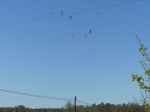I have few words this month and although I hope for everyone to be safe and well I know that there is much worry and suffering for so many. Our life here goes on much the same but without the social contact and nature trips like this one from February. We set out on our annual pilgrimage to Donana wetlands where we hope to see great flocks of flamingos. One of our favourite places en route is by the bird sanctuary of Canada de los Pajaros. Many storks gather and nest here. So we stopped to see storks flying high together in a very bright blue sky, nesting in the pines, and making their wonderful bill clapping sounds.

After being quite stork struck I wandered up the path. There was bird poo all over the prickly pear, so I looked up. There were lot of large stork nests. I saw a bird move so got the camera on it. I thought it might have been a young stork or egret. The first photo told me very little but the next few meant that I had got on camera the birds that had eluded me last year.




Yes, indeed, the beak gives it all away and I finally got some good photos of a spoonbill.
Hope this may have made you wonder a little bit about nature and the amazing diversity of birds and beaks. For everyone lisening and looking more at the wonderful birdlife around us. Lets cherish the birds and keep them safe too with good conservation of the habitats they need.
Rushing to update now as this all ran ahead of me and published with a mind of its own. More on Donana and explorations around Finca Navasola next time. Love to all.









It’s not a blackbird! It’s too big.
LikeLike
Hi Opher, it posted before I finished. You should be able to see all the photos now and see what bird it is!
LikeLike
More to follow?
LikeLike
Yes, a slip of the keyboard or the set featured image published itself first! Guess it made the guessing game more prolonged.
LikeLike
Fabulous photo. What a trip!
LikeLiked by 1 person
Thanks, yes a good memory.
LikeLiked by 1 person
So cool, I love your photos. What an amazing looking bird and bill.
LikeLiked by 1 person
Thanks, the bird called a spoonbill or espatula in Spanish! I was lucky to spot it.
LikeLike
Beautiful photos of the spoonbill and storks. I saw a lot of storks and their nests when I was in Morocco and Latvia. Hope you’re well.
LikeLiked by 1 person
Sending hugs. Hope you’re all okay…
Love the pictures!
Love, light, and glitter
LikeLike
Gorgeous pictures!
LikeLike
Thanks, Andrea and hope all going well for you. My delay is suffering poor internet but no real hardships here!
LikeLiked by 1 person
Glad to hear it.
LikeLike
I love the photos! What a wonderful place to visit and a great memory too. Stay safe and keep well xx
LikeLike
Thanks, Clare, all good here and hope for you too. Just little internet reception so sorry for delay in replying.
LikeLiked by 1 person
No apology needed, Georgina. I’m glad you’re fine – we are too.
LikeLiked by 1 person
Gosh I would be stork struck too! Wonderful photo of the spoonbill 🙂
LikeLiked by 1 person
Sorry for slow response but slow internet. Rural life but hay, all good here. Impressed by your prime minister too. She is certainly a leader and hope all is good for you and yours. Was lucky to capture the spoonbill.
LikeLiked by 1 person
We are so very lucky with our leader 🙂
LikeLiked by 1 person
Interesting to see white storks nesting. They migrate as far south as South Africa, but very few breed while here and only in a very few isolated regions. I love your photos of the spoonbills, and was interested to see how they differ from African spoonbills (who have red faces and pink legs and no crest).
We can look forward to the time in the future when perhaps such nature trips will once again become possible. In the meantime it is comforting to know that the birds continue on in such places.
LikeLiked by 1 person
Interesting, I will look up the African ones. There are also glossy ibis in the Wetlands. I hope too there will be travel again with a very good nature purpose and as sustainable as possible. Storks are amazing travellers, some fitted with satellite tracking too to see where they go!
LikeLiked by 1 person
The glossy ibis occurs in some regions of southern Africa too. Yes when travel does resume (for humans) one can hope it will be of a more sustainable nature.
LikeLike